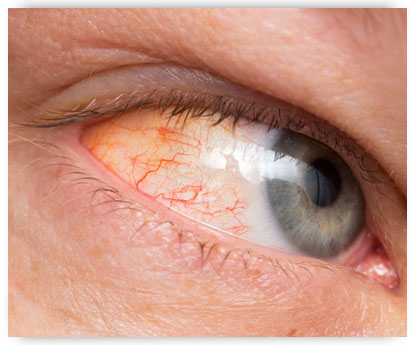Conjunctivitis
Conjunctivitis (also called “madras eye” or “pink eye“) is an inflammation of the conjunctiva (the outermost layer of the eye and the inner surface of the eyelids), most commonly due to a allergic reaction or infection.
Signs and symptoms

Redness, irritation and watering of the eyes are symptoms common to all forms of conjunctivitis.
Acute Conjunctivitis
Acute conjunctivitis is typically caused by either an allergy, virus, or bacteria. Typically, it is associated with a red eye and discharge.
Allergic
Allergic conjunctivitis is typically itchy, sometimes distressingly so, and often involves some eye swelling. Chronic allergy often causes just itching or irritation.
Allergic conjunctivitis shows pale watery swelling of the conjunctiva and sometimes the whole eyelid, often with a ropy, non-purulent mucoid discharge. There is variable redness.
Itching must be a primary symptom to make this diagnosis.
Viral
Viral conjunctivitis is often associated with an infection of the upper upper respiratory tract.. Its symptoms include watery discharge and variable itch. The infection usually begins with one eye, but may spread easily to the other.
Viral conjunctivitis, commonly known as “pink eye,”shows a fine diffuse pinkness of the conjunctiva which is easily mistaken for the ‘ciliary injection’ of iritis, but there are usually corroborative signs on biomicroscopy.
Bacterial
Bacterial conjunctivitis due to the common pus-producing bacteria causes marked grittiness/irritation and a stringy, opaque, grey or yellowish discharge (gowl, goop, gunk, googies, eye crust, or other regional names, officially known as “gound” that may cause the lids to stick together (matting), especially after sleeping. Another symptom that could be caused by bacterial conjunctivitis is severe crusting of the infected eye and the surrounding skin. However discharge is not essential to the diagnosis, contrary to popular belief.
Pyogenic bacterial conjunctivitis shows an opaque purulent discharge, a very red eye, and on bio microscopy there are numerous white cells and desquamated epithelial cells seen in the tear duct along the lid margin. The tarsal conjunctiva is a velvety red and not particularly follicular. Non-pyogenic infections can show just mild infection and be difficult to diagnose. Scarring of the tarsal conjunctiva is occasionally seen in chronic infections, especially in trachoma.
Chemical
Irritant or toxic conjunctivitis is irritable or painful when the infected eye is pointed far down or far up. Discharge and itch are usually absent. This is the only group in which severe pain and discomfort may occur.
Irritant or toxic conjunctivitis show primarily marked redness. If due to splash injury, it is often present only in the lower conjunctival sac. With some chemicals, above all, with caustic alkalis such as sodium hydroxide —there may be necrosis of the conjunctiva with a deceptively white eye due to vascular closure, followed by sloughing of the dead epithelium.

